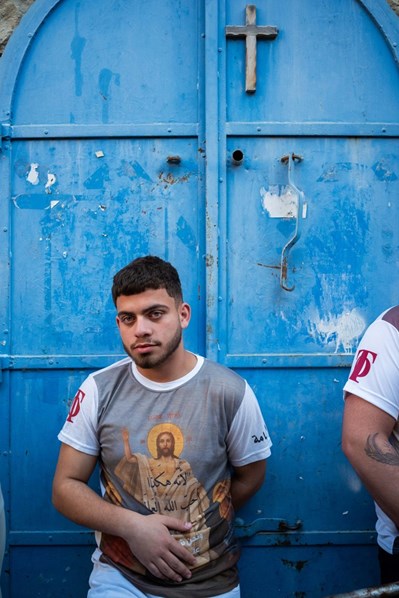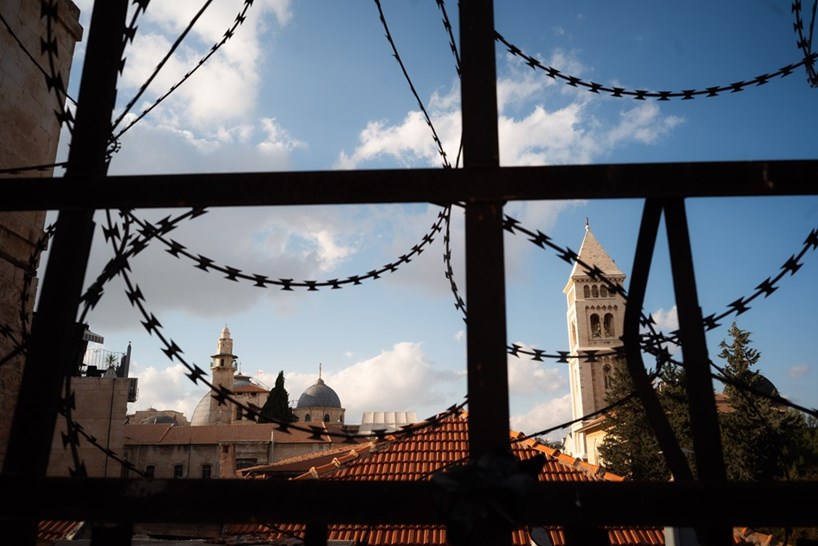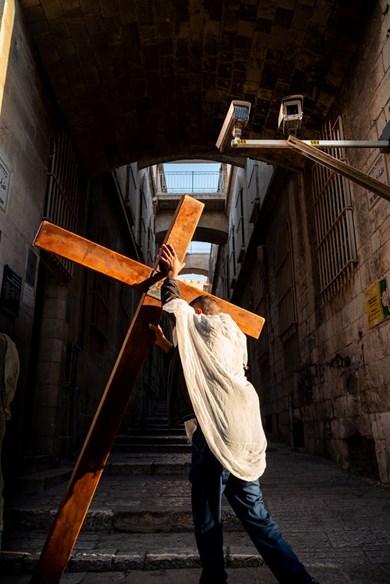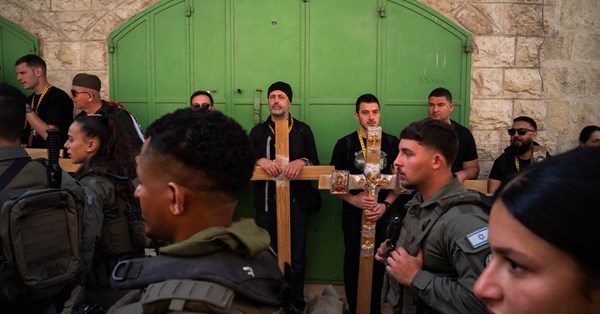IF JERUSALEM is to remain, as many see it, the beating heart of Christianity, then it needs its lifeblood: its Christian inhabitants. A majority in ancient times, they are now a minority within a minority. Numbering only 6000, they are caught between two states in a land annexed and illegally occupied.
Those who were born and have resided there for generations often find themselves in an unresolved dilemma about their identity. In living history, one family can have had three different official identities: Israeli, Jordanian, or Palestinian.
As Lourd, a young Orthodox Christian put it: “Mostly people here [in Jerusalem] have a Jordanian or Israeli passport. So, it depends on what you have [on] a passport. But mostly Arabs, we are in between — Arab Christians especially — as they cannot identify as Israeli [either]. If you are Muslim, you’ll probably tend to identify as Palestinian.”
 William Jones-Warner A young Christian at the Holy Fire ceremony wearing a T-shirt that says “Christ is risen” in Arabic
William Jones-Warner A young Christian at the Holy Fire ceremony wearing a T-shirt that says “Christ is risen” in Arabic
This view is echoed by others across Jerusalem. This misconception extends internationally, where Palestinians and Arabs are often assumed to be Muslim, leaving Christian Arabs overlooked in the Israeli-Palestinian narrative, Lourd says. “Arabs are just known as Muslims; they don’t know that there are Christians. We are the lesser minority.” This ambiguity allows the Christian population to be isolated and targeted.
But the targeting of Christians in Jerusalem is nuanced. There is the perceived state-level targeting of all Christian institutions via the reintroduction of the ground tax, landing the churches with bills that would require the selling of large swaths of land. I spoke with Asaad, a human-rights lawyer who was working closely with the churches in the city. “Now, they want all the churches to start paying . . . after 50 years. They never asked churches to pay. Now, they want churches to pay,” he says.
But there is also the targeting of religious ceremonies. The Holy Fire ceremony — symbolising the resurrection of Jesus — has become an increasing target for aggression and restriction of attendance. In the past, the ceremony was attended by more than 50,000 people from all over the world, but the numbers are limited to 2000 in the church, owing to apparent safety concerns; and people are refraining from coming, owing to increasing tensions with the police. As Asaad puts it, “people are not daring to come because they can be beaten, they can be arrested. . . We cannot take it. . . I don’t want, my four-year-old child, to bring him here. . . Look at your father, he is fighting with the police.”
This Easter, the Greek Orthodox Scout group, an organisation mainly of children, with adult leaders, experienced several incidents with the police, both arising from a refusal by the police to allow Scouts to fulfil their duties on Holy Saturday as agreed by the Status Quo, a set of historical and legal arrangements that regulate the possession and administration of Christian holy sites. In one incident, of which a video has been circulating on social media, a police officer raised his side arm to the face of a Scout leader, a parishioner of St Jacob’s Greek Orthodox Cathedral, in front of the shocked children.
In a second, more isolated incident, a father and son in Scout uniform were denied entry into the Old City. When the father was confronted aggressively by a police officer, the 17-year-old son stepped between them to de-escalate the situation. Four officers responded by assaulting the boy, tearing his shirt in the process.
 William Jones-WarnerWilliam Jones-Warner
William Jones-WarnerWilliam Jones-Warner
I spoke to the father, Hani: “He [the police officer] started to hit, and, you know, my son is 17 years old; so he tried to defend me. . . I put my hands high, because I know there are cameras, and, if you hit any soldier, it will become your problem. Then four soldiers started beating him [his son] . . . and he was in his Scout uniform.” The incident left his son shaken and with a torn shirt. “This is the worst year,” Hani says.
There is a consensus that this year was the worst in terms of the restriction of worship and violence by the authorities, and there is the feeling that the Christian population is being singled out. “They don’t do these things for neither Muslims nor Jews, but because our [Christian] numbers are not sufficient enough. They do whatever they want.”
There has also been increasing incidence of personal attacks, such as spitting on clergy and Christian icons. Data collected by the Rossing Institute in 2024 says: “Priests and nuns living in certain areas of Jerusalem — such as the Armenian Quarter and Mount Zion in the Old City — now face an almost certain risk of harassment each time they step outside.”
Most Christians have left for other countries, and only the most persistent remain. So, where are they to turn for help? There is a feeling of abandonment among the Christians here. Asaad says: “Christianity is the biggest faith in the world. . . What are people like the Vatican . . . what is this massive international community doing to protect the population who share their faith in Jerusalem?”
 William Jones-WarnerAn Ethiopian Orthodox man struggles to lift up his cross on the Via Dolorosa, under CCTV cameras
William Jones-WarnerAn Ethiopian Orthodox man struggles to lift up his cross on the Via Dolorosa, under CCTV cameras
As tensions across the region continue to rise, the challenges facing Christians in Jerusalem are increasingly overshadowed by the escalating humanitarian crisis in Gaza. Just this week, the UN World Food Programme (WFP) announced that it had depleted all food supplies in the territory, after an Israeli blockade on humanitarian aid since 2 March. As WFP-supported bakeries shut down and food parcel distributions end, rates of acute malnutrition — especially among children — are climbing rapidly. International attention is focused squarely on Gaza, and the Christians of Jerusalem and the West Bank feel forgotten.
The churches in the old city are working together to survive, however. All over the city, there are signs of collaboration, from the shared guarding of Christ’s tomb by the Greek, Armenian, and Latin Churches to the cross-Church teaching of seminarians by senior clergy, and the collaborative readings and sermons at special events. This collaboration peaked when the Churches came together to dispute the reinstation of the ground tax, demonstrating that they would stand together when threatened.
In one of the cafés in the Christian quarter, I saw bishops of different Churches in their ordinary clothes having coffee and a laugh together. The Christians I spoke to remained positive: they are people living next to the holy tomb. Time and again, I heard the same sentiment: that there was space for everyone in Jerusalem, Jews, Christians, Muslims, and secular communities alike, and that this was how the city must live. But they also long for recognition from the international community of what is going on, and do not want to be forgotten.
















